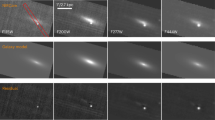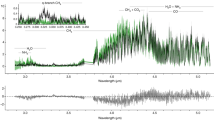Abstract
When a supermassive black hole at the centre of a galaxy accretes matter, it gives rise to a highly energetic phenomenon: an active galactic nucleus1,2. Numerous physical processes have been proposed to account for the funnelling of gas towards the galactic centre to feed the black hole. There are also several physical processes that can remove gas from a galaxy3, one of which is ram-pressure stripping by the hot gas that fills the space between galaxies in galaxy clusters4. Here we report that six out of a sample of seven ‘jellyfish’ galaxies—galaxies with long ‘tentacles’ of material that extend for dozens of kiloparsecs beyond the galactic disks5,6—host an active nucleus, and two of them also have galactic-scale ionization cones. The high incidence of nuclear activity among heavily stripped jellyfish galaxies may be due to ram pressure causing gas to flow towards the centre and triggering the activity, or to an enhancement of the stripping caused by energy injection from the active nucleus, or both. Our analysis of the galactic position and velocity relative to the cluster strongly supports the first hypothesis, and puts forward ram pressure as another possible mechanism for feeding the central supermassive black hole with gas.
This is a preview of subscription content, access via your institution
Access options
Access Nature and 54 other Nature Portfolio journals
Get Nature+, our best-value online-access subscription
$29.99 / 30 days
cancel any time
Subscribe to this journal
Receive 51 print issues and online access
$199.00 per year
only $3.90 per issue
Buy this article
- Purchase on Springer Link
- Instant access to full article PDF
Prices may be subject to local taxes which are calculated during checkout




Similar content being viewed by others
References
Krawczynski, H. & Treister, E. Active galactic nuclei the physics of individual sources and the cosmic history of formation and evolution. Front. Phys. 8, 609–629 (2013)
Heckman, T. M. & Best, P. N. The coevolution of galaxies and supermassive black holes: insights from surveys of the contemporary universe. Annu. Rev. Astron. Astrophys. 52, 589–660 (2014)
Boselli, A. & Gavazzi, G. Environmental effects on late-type galaxies in nearby clusters. Publ. Astron. Soc. Pacif. 118, 517–559 (2006)
Gunn, J. E. & Gott, J. R. On the infall of matter into clusters of galaxies and some effects on their evolution. Astrophys. J. 176, 1–19 (1972)
Fumagalli, M. et al. MUSE sneaks a peek at extreme ram-pressure stripping events — I. A kinematic study of the archetypal galaxy ESO137–001. Mon. Not. R. Astron. Soc. 445, 4335–4344 (2014)
Ebeling, H. et al. Jellyfish: evidence of extreme ram-pressure stripping in massive galaxy clusters. Astrophys. J. 781, L40–L44 (2014)
Magorrian, J. et al. The demography of massive dark objects in galaxy centers. Astron. J. 115, 2285–2305 (1998)
Gültekin, K. et al. The M-σ and M-L relations in galactic bulges, and determinations of their intrinsic scatter. Astrophys. J. 698, 198–221 (2009)
Sanders, D. et al. Ultraluminous infrared galaxies and the origin of quasars. Astrophys. J. 325, 74–91 (1988)
Hopkins, P. & Hernquist, L. A characteristic division between the fueling of quasars and Seyferts: five simple tests. Astrophys. J. 694, 599–609 (2009)
Moore, B. et al. Galaxy harassment and the evolution of clusters of galaxies. Nature 379, 613–616 (1996)
White, S. D. M. & Rees, M. J. Core condensation in heavy halos — a two-stage theory for galaxy formation and clustering. Mon. Not. R. Astron. Soc. 183, 341–358 (1978)
Bekki, K. & Couch, W. Starbursts from the strong compression of galactic molecular clouds due to the high pressure of the intracluster medium. Astrophys. J. 596, L13–L16 (2003)
Poggianti, B. M. et al. Jellyfish galaxy candidates at low redshift. Astron. J. 151, 78–97 (2016)
Poggianti, B. M . et al. GASP I: Gas stripping phenomena in galaxies with MUSE. Astrophys. J. 844, 48 ( 2017)
Bellhouse, C. et al. GASP II. A MUSE view of extreme ram-pressure stripping along the line of sight: kinematics of the jellyfish galaxy JO201. Astrophys. J. 844, 49 (2017)
Gullieuszik, M. et al. GASP IV: A MUSE view of extreme ram-pressure stripping in the plane of the sky: the case of jellyfish galaxy JO204. Astrophys. J. (in the press)
Kewley, L. J. et al. Optical classification of southern warm infrared galaxies. Astrophys. J. Suppl. Ser. 132, 37 (2001)
Kauffmann, G. et al. The host galaxies of active galactic nuclei. Mon. Not. R. Astron. Soc. 346, 1055 (2003)
Sharp, R. G. & Bland-Hawthorn, J. Three-dimensional integral field observations of 10 galactic winds. I. Extended phase (≥ 10 Myr) of mass/energy injection before the wind blows. Astrophys. J. 711, 818 (2010)
Kewley, L. J. et al. The host galaxies and classification of active galactic nuclei. Mon. Not. R. Astron. Soc. 372, 961–976 (2006)
Marziani, P. et al. Emission line galaxies and active galactic nuclei in WINGS clusters. Astron. Astrophys. 599, A83 (2017)
Brinchmann, J. et al. The physical properties of star-forming galaxies in the low-redshift Universe. Mon. Not. R. Astron. Soc. 351, 1151–1179 (2004)
Schulz, S. & Struck, C. Multi stage three-dimensional sweeping and annealing of disc galaxies in clusters. Mon. Not. R. Astron. Soc. 328, 185–202 (2001)
Tonnesen, S. & Bryan, G. L. Gas stripping in simulated galaxies with a multiphase interstellar medium. Astrophys. J. 694, 789–804 (2009)
Tonnesen, S. & Bryan, G. L. Star formation in ram pressure stripped galactic tails. Mon. Not. R. Astron. Soc. 422, 1609–1624 (2012)
Ramos-Martinez, M. & Gomez, G. C. MHD simulations of ram pressure stripping of disk galaxies, in Galaxies at high redshift and their evolution over cosmic time. IAU Symp. 319, 143–143 (2016)
Bower, R. et al. Breaking the hierarchy of galaxy formation. Mon. Not. R. Astron. Soc. 370, 645–655 (2006)
Jaffé, Y. et al. BUDHIES II: a phase-space view of H I gas stripping and star formation quenching in cluster galaxies. Mon. Not. R. Astron. Soc. 448, 1715–1728 (2015)
Navarro, J. F., Frenk, C. S. & White, S. D. M. A universal density profile from hierarchical clustering. Astrophys. J. 490, 493–508 (1997)
Chabrier, G. Galactic stellar and substellar initial mass function. Publ. Astron. Soc. Pacif. 115, 763–795 (2003)
Moretti, A. et al. OmegaWINGS: spectroscopy in the outskirts of local clusters of galaxies. Astron. Astrophys. 599, A81 (2017)
Bacon, R. et al. The MUSE second-generation VLT instrument. Proc. SPIE 7735, 773508 (2010)
Fossati, M. et al. MUSE sneaks a peek at extreme ram-pressure stripping events — II. The physical properties of the gas tail of ESO137-001. Mon. Not. R. Astron. Soc. 455, 2028–2041 (2016)
Boselli, A. et al. Spectacular tails of ionized gas in the Virgo cluster galaxy NGC 4569. Astron. Astrophys. 587, A68 (2016)
Fritz, J. et al. GASP III. JO36: a case of multiple environmental effects at play? Preprint at http://arXiv.org/abs/1704.05088 (2017)
Bressan, A. et al. PARSEC: stellar tracks and isochrones with the PAdova and TRieste Stellar Evolution Code. Mon. Not. R. Astron. Soc. 427, 127–145 (2012)
Ferland, G. J. et al. The 2013 release of CLOUDY. Rev. Mex. Astron. Astrofis. 49, 137–163 (2013)
Cappellari, M. & Emsellem, E. Parametric recovery of line-of-sight velocity distributions from absorption-line spectra of galaxies via penalized likelihood. Publ. Astron. Soc. Pacif. 116, 138–147 (2004)
Vazdekis, A. et al. Evolutionary stellar population synthesis with MILES — I. The base models and a new line index system. Mon. Not. R. Astron. Soc. 404, 1639–1671 (2010)
Cappellari, M. & Copin, Y. Adaptive spatial binning of integral-field spectroscopic data using Voronoi tessellations. Mon. Not. R. Astron. Soc. 342, 345–354 (2003)
Diehl, S. & Statler, T. S. Adaptive binning of X-ray data with weighted Voronoi tessellations. Mon. Not. R. Astron. Soc. 368, 497–510 (2006)
Sarzi, M. et al. The SAURON project — XVI. On the sources of ionization for the gas in elliptical and lenticular galaxies. Mon. Not. R. Astron. Soc. 402, 2187–2210 (2010)
Yan, R. & Blanton, M. R. The nature of LINER-like emission in red galaxies. Astrophys. J. 747, 61 (2012)
Singh, R. et al. The nature of LINER galaxies. Ubiquitous hot old stars and rare accreting black holes. Astron. Astrophys. 558, A43 (2013)
Belfiore, F. et al. SDSS IV MaNGA — spatially resolved diagnostic diagrams: a proof that many galaxies are LIERs. Mon. Not. R. Astron. Soc. 461, 3111–3134 (2016)
Allen, M. G. et al. The MAPPINGS III library of fast radiative shock models. Astrophys. J. Suppl. Ser. 178, 20–55 (2008)
Owers, M. et al. Shocking tails in the major merger Abell 2744. Astrophys. J. 750, L23 (2012)
Cava, A. et al. WINGS-SPE spectroscopy in the WIde-field Nearby Galaxy-cluster Survey. Astron. Astrophys. 495, 707–719 (2009)
Wang, S. et al. CHANDRA ACIS survey of X-ray point sources: the source catalog. Astrophys. J. Suppl. Ser. 224, 40 (2016)
Acknowledgements
This work is based on observations collected at the European Organisation for Astronomical Research in the Southern Hemisphere under ESO programme 196.B-0578. We thank M. Fossati and D. Wilman for developing and making available KUBEVIZ. We acknowledge financial support from PRIN-INAF 2014. B.V. acknowledges support from an Australian Research Council Discovery Early Career Researcher Award (PD0028506). S.T. was supported by an Alvin E. Nashman Fellowship in Theoretical Astrophysics. This work was co-funded under the Marie Curie Actions of the European Commission (FP7-COFUND).
Author information
Authors and Affiliations
Contributions
All authors contributed to the interpretation of the observations and the writing of the paper. B.M.P. led the project and performed the data analysis. Y.J. performed the phase-space analysis. A.M. carried out the stellar kinematics analysis. M.G. did the data reduction. M.R. contributed to the data analysis. S.T. provided the discussion on simulations. J.F. did the SINOPSIS analysis. D.B. and G.F. helped in the preparation of the observations. B.V. performed a comparison of the stellar population analysis and prepared the GASP web page. C.B. performed the two-component KUBEVIZ analysis of JO201. G.H. did the data reduction for JO201. A.O. selected the JW100 target.
Corresponding author
Ethics declarations
Competing interests
The authors declare no competing financial interests.
Additional information
Publisher's note: Springer Nature remains neutral with regard to jurisdictional claims in published maps and institutional affiliations.
Extended data figures and tables
Extended Data Figure 1 Summary diagnostic diagrams.
Line ratio diagrams summarizing our findings, showing the location of each galaxy in two different diagnostics diagrams integrating the spectrum over the spatial region (identified from Fig. 3) dominated by AGN emission (JO201, JO204, JW100, JO206, JO135), by LINER emission (JO194) and over the central 7 × 7 brightest spaxels in the case of JO175. Here we present both the [N ii]6,583/Hα (left) and the [S ii]6,717/Hα (right) diagrams, to illustrate the good agreement between the two and also to display JW100 whose [N ii] line cannot be measured. Lines as in Fig. 3. The two components in JO201, JO204 and JW100 are shown as separate points. The error bars are computed propagating the errors on the line fluxes obtained by KUBEVIZ, scaled to achieve a reduced χ2 = 1 as described elsewhere15.
Rights and permissions
About this article
Cite this article
Poggianti, B., Jaffé, Y., Moretti, A. et al. Ram-pressure feeding of supermassive black holes. Nature 548, 304–309 (2017). https://doi.org/10.1038/nature23462
Received:
Accepted:
Published:
Issue Date:
DOI: https://doi.org/10.1038/nature23462
This article is cited by
-
Astrophysics with the Laser Interferometer Space Antenna
Living Reviews in Relativity (2023)
-
Ram pressure stripping in high-density environments
The Astronomy and Astrophysics Review (2022)
-
Highly ordered magnetic fields in the tail of the jellyfish galaxy JO206
Nature Astronomy (2020)
-
Observational constraints on the feeding of supermassive black holes
Nature Astronomy (2019)
Comments
By submitting a comment you agree to abide by our Terms and Community Guidelines. If you find something abusive or that does not comply with our terms or guidelines please flag it as inappropriate.



